Dissecting sources of quantitative gene expression pattern divergence between Drosophila species
- PMID: 22893002
- PMCID: PMC3435502
- DOI: 10.1038/msb.2012.35
Dissecting sources of quantitative gene expression pattern divergence between Drosophila species
Abstract
Gene expression patterns can diverge between species due to changes in a gene's regulatory DNA or changes in the proteins, e.g., transcription factors (TFs), that regulate the gene. We developed a modeling framework to uncover the sources of expression differences in blastoderm embryos of three Drosophila species, focusing on the regulatory circuit controlling expression of the hunchback (hb) posterior stripe. Using this framework and cellular-resolution expression measurements of hb and its regulating TFs, we found that changes in the expression patterns of hb's TFs account for much of the expression divergence. We confirmed our predictions using transgenic D. melanogaster lines, which demonstrate that this set of orthologous cis-regulatory elements (CREs) direct similar, but not identical, expression patterns. We related expression pattern differences to sequence changes in the CRE using a calculation of the CRE's TF binding site content. By applying this calculation in both the transgenic and endogenous contexts, we found that changes in binding site content affect sensitivity to regulating TFs and that compensatory evolution may occur in circuit components other than the CRE.
Figures

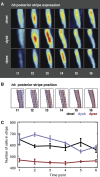
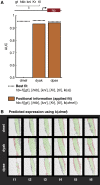
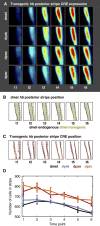
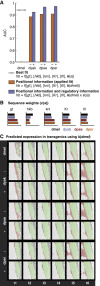
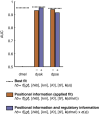
Similar articles
-
Bicoid occurrence and Bicoid-dependent hunchback regulation in lower cyclorrhaphan flies.Evol Dev. 2008 Jul-Aug;10(4):413-20. doi: 10.1111/j.1525-142X.2008.00252.x. Evol Dev. 2008. PMID: 18638318
-
Sepsid even-skipped enhancers are functionally conserved in Drosophila despite lack of sequence conservation.PLoS Genet. 2008 Jun 27;4(6):e1000106. doi: 10.1371/journal.pgen.1000106. PLoS Genet. 2008. PMID: 18584029 Free PMC article.
-
Regulatory and coding regions of the segmentation gene hunchback are functionally conserved between Drosophila virilis and Drosophila melanogaster.Mech Dev. 1994 Feb;45(2):105-15. doi: 10.1016/0925-4773(94)90024-8. Mech Dev. 1994. PMID: 8199047
-
Identification of hunchback cis-regulatory DNA conferring temporal expression in neuroblasts and neurons.Gene Expr Patterns. 2012 Jan-Feb;12(1-2):11-7. doi: 10.1016/j.gep.2011.10.001. Epub 2011 Oct 20. Gene Expr Patterns. 2012. PMID: 22033538 Free PMC article.
-
The structure and evolution of cis-regulatory regions: the shavenbaby story.Philos Trans R Soc Lond B Biol Sci. 2013 Nov 11;368(1632):20130028. doi: 10.1098/rstb.2013.0028. Print 2013 Dec 19. Philos Trans R Soc Lond B Biol Sci. 2013. PMID: 24218640 Free PMC article. Review.
Cited by
-
Combinatorial Gene Regulation through Kinetic Control of the Transcription Cycle.Cell Syst. 2017 Jan 25;4(1):97-108.e9. doi: 10.1016/j.cels.2016.11.012. Epub 2016 Dec 29. Cell Syst. 2017. PMID: 28041762 Free PMC article.
-
TALE-mediated modulation of transcriptional enhancers in vivo.Nat Methods. 2013 Aug;10(8):762-7. doi: 10.1038/nmeth.2543. Epub 2013 Jun 30. Nat Methods. 2013. PMID: 23817068 Free PMC article.
-
Evidence for deep regulatory similarities in early developmental programs across highly diverged insects.Genome Biol Evol. 2014 Sep;6(9):2301-20. doi: 10.1093/gbe/evu184. Genome Biol Evol. 2014. PMID: 25173756 Free PMC article.
-
Boolean modeling of gene regulatory networks: Driesch redux.Proc Natl Acad Sci U S A. 2012 Nov 6;109(45):18239-40. doi: 10.1073/pnas.1215732109. Epub 2012 Oct 1. Proc Natl Acad Sci U S A. 2012. PMID: 23027966 Free PMC article. No abstract available.
-
An Atlas of Transcription Factors Expressed in Male Pupal Terminalia of Drosophila melanogaster.G3 (Bethesda). 2019 Dec 3;9(12):3961-3972. doi: 10.1534/g3.119.400788. G3 (Bethesda). 2019. PMID: 31619460 Free PMC article.
References
-
- Ardehali MB, Lis JT (2009) Tracking rates of transcription and splicing in vivo. Nat Struct Mol Biol 16: 1123–1124 - PubMed
-
- Arnosti DN, Barolo S, Levine M, Small S (1996) The eve stripe 2 enhancer employs multiple modes of transcriptional synergy. Development 122: 205–214 - PubMed
-
- Ben-Tabou de-Leon S, Davidson EH (2007) Gene regulation: gene control network in development. Annu Rev Biophys Biomol Struct 36: 191. - PubMed
MeSH terms
Substances
LinkOut - more resources
Full Text Sources
Molecular Biology Databases
Miscellaneous

